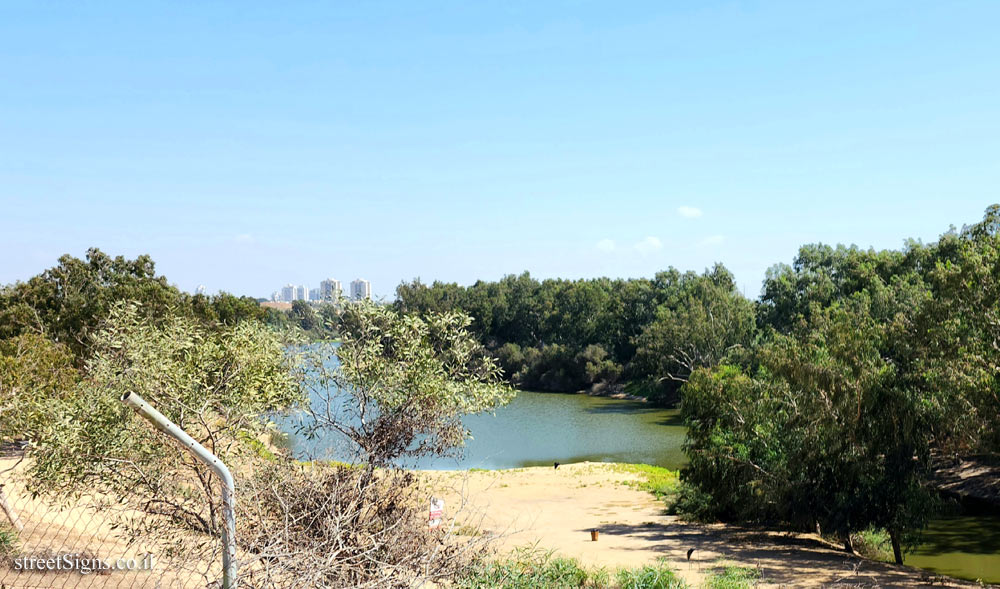The lake was photographed on the same day by the same photographer
 Click for a larger image Translation of the text on the sign
Click for a larger image Translation of the text on the sign:
Beaches and Lakes Division symbol
Environmental Quality Administration symbol
The symbol of the city of Rishon Lezion - Rishon Lezion you are in the center
Agmon Hanikik, Rishon Lezion - birdwatching and urban nature site The Hanikik Reservoir, which was established by the Municipal Water Company "Maniv" and is maintained by the Beaches and Lakes Division, in the Rishon Lezion Municipality, is fed by the surface runoff water of the city of Rishon Lezion and its surroundings. The water stored in the nearby Superland Reservoir is pumped and discharged into the Hanikik Lake, and permeates and enriches the Groundwater aquifer.
The lake also creates a unique humid habitat, surrounded by sandy banks and developed ash and eucalyptus trees. The water, full of fish, including gambosia fry that prevent mosquito breeding, are used as fishing grounds for the Pied kingfisher and the Common kingfisher, the gray heron and the small and great egret. The sandy banks, inhabited by molluscs and tiny crustaceans, are home to Common greenshank, Common sandpiper and White-winged tern. During the migration seasons they are also joined by the Little ringed plover, Common ringed plover and the Little stint. A green and moist meadow, which is formed on the eastern edge of the reed, is used in winter by the Green Sandpiper, the Water pipit, The Grey wagtail and the Bluethroat. The large hazel and eucalyptus trees create nesting and roosting sites for night herons and Bubulcus. For the Little egrets and Ibis and observation and resting places for the many Common buzzards that hunt the rodents. Partridges hide and nest in the hazel thickets. For those who arrive early in the morning, there is a good chance to see a deer or two feeding on the grass.
Due to the relative remoteness of the gorge lake from sources of noise and human disturbance, it has become the home of many bird photographers who document the beauty of nature here.
What can be seen in the lake? All year round (steady):
Pied kingfisher: A black and white kingfisher that specializes in hunting fish while fluttering and floating above the surface of the water. The kingfishers nest in the reeds in upright sand walls, in burrows that can be up to 2 meters long. The kingfishers can be seen here throughout the year fluttering above the water or resting on prominent tree branches, sometimes in small groups.
[Image]
Pied kingfisher: Photo: Avi Meir
In winter:
Great cormorant: a large sea fowl that feeds on fish and arrives in small flocks to the lake towards October. Captures its food by diving to a great depth, sometimes with the sophisticated cooperation of the entire group. The cormorant is equipped with strong legs decorated with swimming membranes and long, strong wings. It can often be seen spreading its wings to dry in the sun.
[Image]
Great Cormorant. Photo: Avi Meir
During the migration seasons and winter:
Common redshank: a bird of the Charadriiformes family that lives in shallow bodies of water and feeds on molluscs, worms and insects, living in soft muddy soil. In Europe and Asia, the marsh wagtail spends the summer in swamps or high mountain grasslands. It can be seen loitering on the ground or flying while making a characteristic high-pitched call, mainly during its migration in September and April, but also in smaller numbers in winter.
[Image]
Common redshank. Photo: Avi Meir
[More photos - from right to left]
Common buzzard - Photo: Avi Meir, White wagtail - Photo: Avi Meir, White-throated kingfisher - Photo: Avi Meir, Great egret - Photo: Avi Meir, Black-crowned night heron - Photo: Avi Meir, Rufous-tailed scrub robin - Photo: Avi Meir, Bluethroat - Photo: Avi Meir, Common kingfisher - Photo: Avi Meir
Learn about:

 Click for a larger image
Click for a larger image